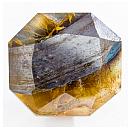|
|
||||||||||||||||
|
||||||||||||||||
|
||||||
|
|
|
|
Binghamite
(a
mixture of minerals) |
|
| | |
| Discovered in 1936; IMA status: Not Valid (trade name) | ||
|
| ||
|
Chemistry |
|
|
| |
|
(Quartz) SiO2 + (Goethite) a-Fe3+O(OH) |
|
Classification |
|
|
| |
|
Oxides (mixture of the Oxides Quartz and Goethite and/or Hematite) | |
|
|
|
|
Crystal Data |
|
|
|
|
|
Tetragonal - Trapezohedral (Quartz) |
|
|
|
|
|
Physical Properties |
|
|
|
|
|
Conchoidal (Quartz) |
|
|
Brittle |
|
|
7.0 (Quartz) |
|
|
Not Radioactive |
|
|
|
|
|
Optical Properties |
|
|
|
|
|
Yellow to Golden Yellow, Reddish (Chalcedony), Black (Goethite or Hematite) |
|
|
Transparent to Opaque |
|
|
Vitreous |
|
|
Other: |
Chatoyant |
|
|
|
|
Occurances |
|
|
|
|
|
Geological Setting: |
The formation of the stone occurs near deposits of iron ore. |
|
Common Associations: |
Goethite, Hematite, Iron |
|
Type Locality: |
Cuyuna, Crow Wing County, Minnesota, USA |
|
Year Discovered: |
1936 |
|
|
|
|
More Information |
|
|
|
|
|
|
Mindat.org
(Binghamite) |
|
|
|
|
|
|
|
We
have not photographed our Binghamite gems
yet. Please
check back soon. |
